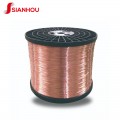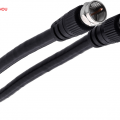What Coax Cable Type Can I Choose,RG59 or RG6?
Hot Blog
- Difference between super cat5…
Date:2022-11-24
1. It is the difference in performance between the two. The most important part of the difference between the super-category five network cable and the six-type network cable is that its performance is different. Although the Cat5e line and Cat6 line system are capable of transmitting Gigabit network speed, the standard used by Cat5e line … Continue reading Difference between super cat5 and cat6
- What is CPR Class?
Date:2016-09-11
What is CPR? The CPR (Construction Product Regulation) is a regulation issued by the European Union, in force since 1 st July 2016. The purpose of the CPR is to: Ensure the harmonization across Europe of the materials used in construction Achieve higher safety levels for fire and dangerous substances in materials used in construction … Continue reading What is CPR Class?
What Coax Cable Type Can I Choose,RG59 or RG6?
You may ask :”what coax cable type can i choose ,RG59 or RG6 ?what is the number of shielding? What about braiding? Do i need to get Plenum Rated cable? Or Direct Burial?” There is a seemingly endless list of options and picking the wrong type of coax could result in spending a lot more money than what you were planning. In this comprehensive article we’ll go through a few basics of coaxial cable so you should know what you need.
First, What is RG?
Coaxial cables use RG ratings to distinguish between the different kinds of cables. RG is an old, mostly forgotten military term that stands for “radio guide.” The number distinguishes the different cable specifications, but they are randomly assigned, so don’t look for some type of order in the numbers. Literally dozens of coaxial cables have been made over the years, but the only ones that most people need to worry about are RG 6 cable and RG 59 cable, so those are the two types we are going to focus on here.
RG 6 vs RG 59 Applications
RG 6 is recommended for your CATV, satellite, TV antenna, or broadband internet. RG 59 is generally better for most CCTV systems and other analog video signals. What you really need to consider are the frequency ratings your equipment uses. If your equipment uses higher frequencies (above 50 MHz), then you’ll want to go with RG 6. If your frequencies are lower than that, then you’ll want to use RG 59.
RG 59 (In-Depth)
RG59 cable has been around for a long time. This cable used to be what most people used for their cable TV connection and is very commonly installed in older homes and commercial buildings. However, many modern signal requirements have made this cable less popular in the last few years. RG 59 has a smaller conductor than RG 6, which means that it can’t achieve the same signal quality as RG 6. The way its shielding is designed also means that it doesn’t keep Gigahertz level signals inside the conductor very well. This is why RG 59 probably isn’t a good choice for your TV or internet connection.
The braided shielding in RG 59 was designed around (relatively) long waveforms of megahertz interference. That makes it good for lower frequency signals (anything under about 50 MHz). It is commonly used for composite or component video signals (often in the mini-coax variety). That also makes it a good choice for a closed circuit television (CCTV) video surveillance system. You can even make your installation easier by getting what’s called “Siamese coaxial cable.” This cable consists of a RG 59 cable merged together with a 2C power cable. By using this type of cable, you can run the power and video for your security cameras simultaneously, effectively cutting your install time in half.
RG 6 (In-Depth)
Satellite and internet signals run at higher frequencies than traditional analog video, and when TV broadcasts changed from analog to digital, and cable companies started switching to digital, the higher freuqencies made it necessary to find a more effective coaxial cable. RG6 cable was designed to fulfill these requirements. It has a larger conductor, which gives you much better signal quality. The dielectric insulation was made thicker as well. RG 6 is also made with a different kind of shielding, which allows it to more effectively handle Ghz level signals. While many RG 59 cables uses a foil shield in addition to the braid, RG 6 made it mandatory. The braid was originally in a looser weave (e.g. 60% versus the 90%+ of RG59) but many RG6 cables use a high-percentage braid now too.
Other Factors to Consider When Buying
Deciding between RG 59 and RG 6 is only part of the process. Each class of cable can have different types of shielding or jacket and may or may not be rated for your chosen installation.
RG-6/U
RG-6 can also be found with the designation “RG-6/U,” but there is no official designation for the U. Some say that it means “universal” or “for general utility use.” Others say that it refers to the type of jacket the cable has, but this isn’t always the case. For all intents and purposes RG-6 and RG-6/U are the same. If you need a certain type of jacket, make sure and check the specs. But we’ll get into different jacket types later on.
Shielding
Shielding prevents ‘noise’ from interfering with your signal, and therefore preserves your signal quality. Coaxial cables usually come with two types of shielding: braid and foil. Most coaxial cables include both (although some RG 59 cables still use single shielding). In general, the more shielding you have, the better your cable will perform, especially in longer runs, but there are differences in what the shields protect. Foil shielding typically involves an aluminum or mylar foil bonded to the dielectric, underneath a metal braid. Foil is very effective at protecting against high frequency electromagnetic interference (EMF). Braided shielding is a collection of many small wire strands braided around the outside of dielectric (and/or foil). The braid is effective against lower-frequency interference. RG 59 cable uses a copper braid and RG 6 can use copper or an aluminum braid.
There are “quad shielded” cables that have an extra layer of foil and braid shielding and can offer better protection. However, newer coaxial cables can use a 95% braid to perform better without the extra bulk and weight of quad shielded cables.
Signal Loss
While shielding techniques keep external signal from affecting our signals, there is always some signal loss over the length of any cable. Here’s the breakdown of signal loss (attenuation) in decibels for 100 ft. of cable. Just remember, the longer your cable runs are, the more signal loss you will experience. That’s why it’s best to keep your installation lengths as short as possible.
RG 59 Signal Loss (in dB) per 100 ft
- Loss at 50 MHz: 2.4 dB
- Loss at 100 MHz: 3.4 dB
- Loss at 400 MHz: 7.0 dB
- Loss at 900 MHz: 11.1 dB
- Loss at 1000 MHz: 12.0 dB
RG 6 Signal Loss (in dB) per 100 ft
- Loss at 50 MHz: 1.5 dB
- Loss at 100 MHz: 2.0 dB
- Loss at 400 MHz: 4.3 dB
- Loss at 900 MHz: 6.8 dB
- Loss at 1000 MHz: 7.0 dB
Cable Jacket
Plenum Rating
Plenum spaces are the open spaces above the ceiling or below the floor that are used for air circulation. These spaces are important for air circulation in commercial buildings, but they also bring some problems if you ever have a fire because of the high oxygen content and lack of fire barriers.
Using untreated cables in plenum spaces can spread the fire to other areas very quickly and spread noxious smoke throughout the building. Plenum cables are coated with flame retardant and made using special plastics that don’t release toxic gasses or smoke nearly as much as other plastics to help prevent this problem. Any cable that you run through plenum spaces must be plenum rated.
Outdoor and Direct Burial Coax
If you are running cable outside, it has to have added protection from the weather and the elements. Outdoor cable has been specially designed to resist the elements. They come with a PE (polyethylene) jacket instead or UV treated PVC jacket. The outdoor rated jacket makes this cable extremely resistant to cold weather, moisture, chemicals, abrasion, and cutting.
When you bury a coaxial cable, moisture becomes even more of an obstacle. Without added moisture protection, you risk moisture and contaminants entering into the cable and corroding your shielding and conductor. Direct burial cable has the special PE jacket that outdoor coax has, along with a special gel-like substance in the jacket that blocks water and moisture corroding your conductor and damaging your signal.






